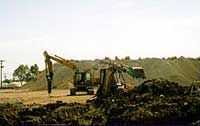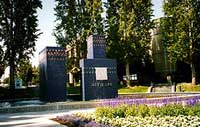Contact Superfund, Pacific Southwest
Pacific Southwest, Region 9
Serving: Arizona, California, Hawaii, Nevada, Pacific Islands, Tribal Nations
Frequently Asked Questions About Superfund Redevelopment


After: Netscape Communication, Inc., now operates on the formerly contaminated Fairchild Semiconductor Superfund site in Silicon Valley.
The following are questions regularly asked of EPA pertaining to the redevelopment of Superfund sites. Answers have been provided. If the responses below do not fully address your questions, you can contact the Superfund Redevelopment Coordinators in Region 9.
- What do you mean by "reuse"?
- What type of Superfund sites can be reused?
- How is Superfund Redevelopment different from the Brownfields Program?
- If a site is valuable, wouldn't use occur without EPA's help?
- Will a Superfund site be safe for reuse?
- Will the goal of reuse lead to the selection of less-protective cleanups in order to facilitate the use?
- What is EPA's authority to consider reuse as part of the remedial process?
- How does EPA Region 9 promote the reuse of a Superfund site?
- What reuse activities can EPA fund using Superfund money?
- More Frequent Questions about Superfund Redevelopment...
- What is the Superfund Return to Use Initiative?
- More Frequent Questions about the Superfund Return to Use Initiative...
What do you mean by "reuse"?
Most contaminated Superfund sites were once productive. "Reuse" means productive use of a site during or after cleanup. These uses can be industrial or commercial, such as factories and shopping malls; they can be used for housing, public works facilities, transportation, and other community infrastructure; they can be for recreational facilities, such as golf courses, parks and ball fields; or for ecological resources, such as wildlife preserves and wetlands. Read more...
What type of Superfund sites can be reused?
EPA supports use at all Superfund sites, both removal and remedial sites.
How is Superfund Redevelopment different from the Brownfields Program?
Both efforts seek productive uses for environmentally impaired properties. But they address different kinds of sites and use different methods to accomplish their objectives. The Superfund Redevelopment Program focuses on federal Superfund sites both removal and remedial. The sites vary widely in size and location, and in the type and severity of contamination. Under Superfund, EPA is actively engaged in the cleanup of these sites and can apply a variety of technical and financial resources related to the use of the properties during cleanup. Brownfields sites are generally abandoned or underutilized industrial or commercial facilities, and are often made up of small parcels with multiple owners. Generally, other than funding the Brownfields Program, EPA is not involved in the cleanup of these properties.
If a site is valuable, wouldn't use occur without EPA's help?
In some cases, yes. Some sites are so favored by their location or other economic factors that use is inevitable. But in most instances, use is not inevitable. Read more....
Will a Superfund site be safe for reuse?
The majority of Superfund sites are protective for reuse. However, not all site cleanups are protective for all uses. Superfund cleanups may be designed to accommodate specific uses. Read more....
Will the goal of reuse lead to the selection of less-protective cleanups in order to facilitate the use?
No. EPA's primary mission under the Superfund program is to protect human health and the environment. The recycling of Superfund sites is secondary. There is nothing in the Superfund Redevelopment Program that will result in the selection of cleanups that are less protective than required. Read more...
What is EPA's authority to consider reuse as part of the remedial process?
Consideration of reasonably anticipated future land use is an activity that is an important and integral part of the remedial process, not only during remedy selection, but also at many other points in the Superfund decision pipeline, including long-term stewardship. It is a vital consideration because it helps to ensure the long-term integrity and protectiveness of the remedy under future use. In pursuing this long-term goal, EPA is committed to (1) working with stakeholders to take into account the reasonably anticipated future land uses; and (2) selecting, designing, and implementing response actions that accommodate the future uses of Superfund sites without compromising the protection of human health and the environment.
Considering future land use in the selection and implementation of remedies has its roots in the National Oil and Hazardous Substances Pollution Contingency Plan (NCP). The NCP preamble specifically discusses use of land use assumptions for the baseline risk assessment, which provides the basis for taking a remedial action at a Superfund site and supports the development of remedial action objectives. Land use assumptions affect the exposure pathways that are evaluated in the baseline risk assessment. Current land use is critical in determining whether there is a current risk associated with a Superfund site; future land use is important in estimating potential future threats and developing cleanup options to address those threats.
Since the publication of the NCP, EPA has issued additional guidance aimed at integrating reuse considerations into the remedial process, including the Land Use Directive (1995) and Reuse Assessments: A Tool to Implement the Land Use Directive (2001). These documents reflect EPA's continuing efforts to incorporate reuse considerations into its daily operations based on new experiences and lessons learned.
How does EPA Region 9 promote the reuse of a Superfund site?
Region 9 facilitates site reuse through site-specific reuse plans, status/comfort letters and other appropriate redevelopment tools, and by emphasizing an early and thorough consideration of the anticipated future use of sites, wherever possible, so that cleanups can be consistent with that use. However, EPA does not determine the specific reuse of a contaminated property or favor one redeveloper over another. Land use determinations are primarily a local government issue.
What reuse activities can EPA fund using Superfund money?
Activities that may be appropriate for funding under Superfund include the following:
- Community needs assessments that identify major issues, needs and desires of the local officials and the community related to the anticipated future use;
- Analyses that identify area market conditions and trends to provide a realistic understanding of the uses and activities that could occur on-site;
- Physical site evaluation to determine assets and constraints of the site and available infrastructure (e.g., transportation, utilities);
- Stakeholder and community outreach on reuse options; and
- Preparation of reports documenting the results of the analyses and describing anticipated future uses, and coordination of the reuse planning activities with the Superfund response process.
More Frequent Questions about Superfund Redevelopment
What is the Return to Use initiative?
The Return to Use initiative (RTU, or "the Initiative") is the latest phase of the Superfund Redevelopment Program. It shares the Program's mission to support community efforts to reuse Superfund sites. It does this by removing barriers that are not needed to protect human health, the environment, or the remedy. Read more...
More Frequent Questions about Superfund Return to Use Initiative
